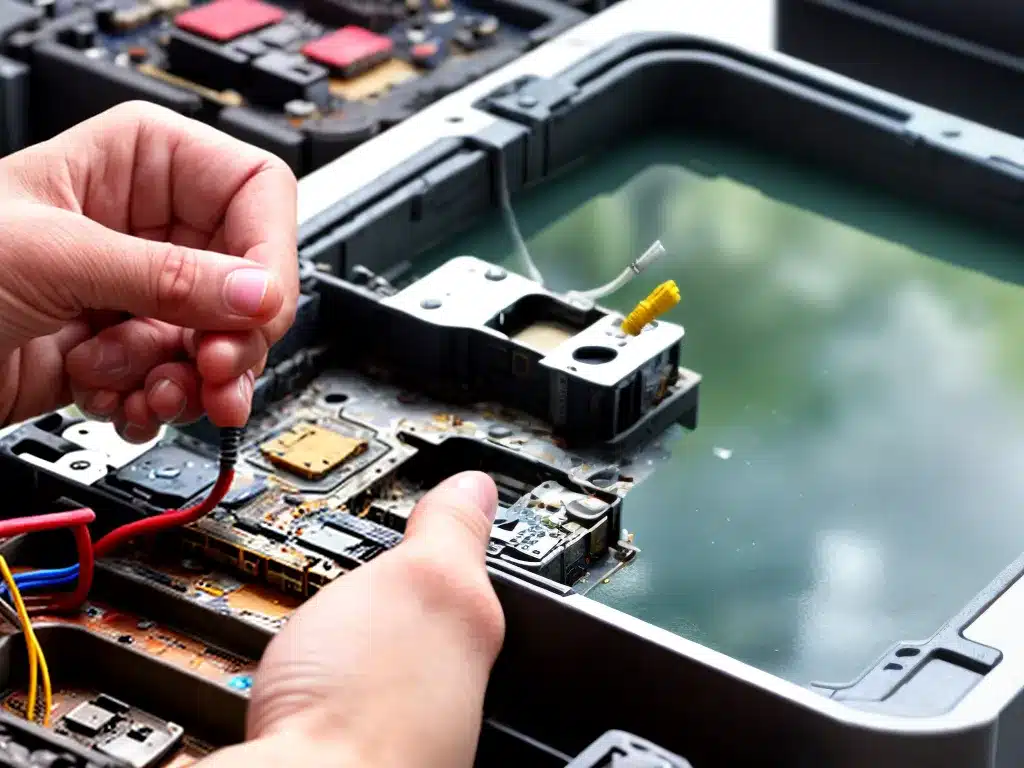
Repairing Water Damaged Electronics
Assessing the Damage
When electronics get exposed to water, it’s important to quickly assess the damage and act fast to try to repair them. Here are some tips on evaluating water damaged electronics:
-
Remove electronics from water source immediately – This helps prevent further damage from occurring. Don’t try to turn electronics on if wet.
-
Dry the electronics – Use a microfiber cloth or compressed air to gently dry the exterior of electronics. Remove batteries and SIM cards first. Do not use heat to dry, as this can further damage electronics.
-
Check for visible damage – Look for corrosion, mineral deposits, residue, or shorts on the logic board. These are bad signs. Also check ports and connectors for water.
-
Consider how long electronics were exposed – The longer electronics sit in water, the more damage is likely to occur. Even brief exposure to water can still cause issues.
-
Determine if electronics turn on – After drying, try turning electronics on. If they don’t power up, it’s a sign of internal damage.
Thoroughly drying electronics is the first step. But if corrosion is present or device won’t turn on, internal repairs are likely needed.
Cleaning Water Residue and Corrosion
If water exposure was brief, cleaning electronics may allow them to work again. Here’s how to clean electronics exposed to water:
Cleaning Steps
-
Disconnect battery and power source – Power down the device if possible first.
-
Use 90% isopropyl alcohol and a soft bristle toothbrush to gently scrub away residue on logic boards and components. Avoid using too much liquid.
-
Rinse with distilled water and dry thoroughly with a microfiber cloth. Tap water contains minerals that can further corrode electronics.
-
Use compressed air to blow out any remaining moisture in crevices and ports.
-
Let electronics dry completely for 24-48 hours before reconnecting the battery and powering on.
Cleaning Tips
-
Avoid getting moisture into any openings – Use alcohol and toothbrush gently to avoid liquid seeping deeper into electronics.
-
Replace any corroded parts – Heavily corroded components may need to be replaced, like batteries or charging ports.
-
Check for shorts – Power on electronics after drying to test for short circuits. Shorts mean component replacement is needed.
-
Repeat cleaning if needed – It may take multiple cleanings over several days to fully remove corrosion and residue.
Thorough cleaning removes contaminants but doesn’t fix internal shorts and corrosion damage. Component-level repair is needed for that.
Internal Repairs for Liquid Damage
If cleaning doesn’t restore function, electronics likely have internal damage that requires repair or replacement of parts. Here are some common fixes:
Logic Board Repair
-
Reflow solder joints – Heating logic board in an oven can re-melt solder and fix short circuits.
-
Replace corroded components – Heavily damaged chips, ports, or sensors on the board may need replacement.
-
Use a multimeter to check traces – Check board for shorts and isolate damage.
Other Repairs
-
Replace batteries – Batteries often corrode and stop working properly after water exposure.
-
Replace speakers/microphones – These components are prone to water damage on phones and laptops.
-
Replace display/LCD – Screens can work initially but fail later due to liquid residue.
-
Replace casing – If device case or housing got warped from water, it may need to be replaced.
-
Replace cable connectors – Ribbon cables and connectors can corrode or short out.
Proper diagnostics and tailored component-level repair is needed for success. Overall, the less time electronics sit in water, the better chance they can be revived with some work.
When to Use a Professional for Repair
Water damaged electronics often require microsoldering and board-level troubleshooting. Here are some signs you may need professional repair:
-
Device has visible corrosion on the logic board
-
Device does not power on at all after liquid exposure
-
You tried repairs but the device is still not fully functioning
-
The device has very delicate components that are easy to damage
-
You do not have the proper tools and skill for microsoldering and disassembly
Many pros have specialized tools and training for microelectronics repair. They can:
-
Safely disassemble devices without damage
-
Use ultrasonic cleaning to fully clean logic boards
-
Have microscopes to inspect boards for damage
-
Perform advanced microsoldering of BGA chips
-
Source replacement parts not available to consumers
Liquid damage often requires repairs beyond basic cleaning. For valuable electronics like phones or laptops, a professional repair is a smart choice if you lack the skills.
Drying Out Wet Electronics (Short Term Fix)
If you can’t repair wet electronics right away, you can try drying them out as a short term fix:
-
Remove power sources like batteries and unplug devices.
-
Absorb excess moisture with a microfiber cloth. Don’t rub or wipe hard.
-
Place the device in front of a fan to aid drying. Do not use heat.
-
Bury device in a bowl of dry rice – the rice will absorb moisture.
-
Place in a sealed bag with desiccant packs to extract moisture.
-
Leave to dry for 24-48 hours. Check for moisture in ports before powering on.
-
Drying can temporarily revive electronics, but it’s not a permanent fix for water damage.
The goal is to dry out the device as much as possible to potentially get it working short term. But permanent repairs will still be needed if liquid got inside.
Conclusion
Liquid damage can seriously harm electronics, but prompt action can often save devices. Thoroughly drying and cleaning residue is the first step, but component-level repair may be necessary if corrosion or shorts are present. For anything beyond minor cleaning, take the device to an experienced professional repair technician. The sooner water damaged electronics are properly repaired, the better the outcome.












